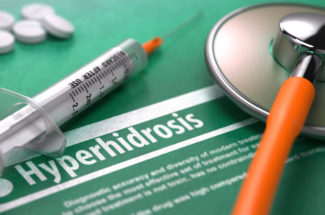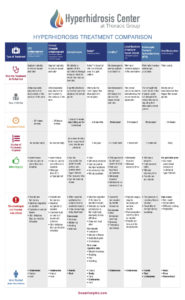Hyperhidrosis is a condition in which excessive sweat occurs in one or multiple parts of the body. It is currently estimated that 7.8 million Americans (or 2.8 percent of the population) are living with this condition.
is a condition in which excessive sweat occurs in one or multiple parts of the body. It is currently estimated that 7.8 million Americans (or 2.8 percent of the population) are living with this condition.
If you count yourself among this group, you may not know where to turn to get the relief you need. At the Hyperhidrosis Center at Thoracic Group, we are here to help you determine what the best treatment options may be to keep you sweat free.
That said, we have put together a comparative list for the variety of treatments available on the market to help guide you through your decision-making process:
Over-the-counter and prescription-strength antiperspirants: These are typically the first line of defense against excessive sweating. They are a low-cost, noninvasive solution if palms, feet or underarms sweat. However, they need to be constantly reapplied on an as-needed basis and may cause skin irritation due to the chemicals they contain. There is also growing concern over the continued use of the identified toxic ingredients over time.
Iontophoresis: Iontophoresis is a procedure in which a device sends gentle electrical currents to the hands and/or feet using water as a conductor. While there is no recovery time for this method, the treatment is time consuming and must be done daily or weekly for life to maintain results. In addition, the application is also limited to hyperhidrosis of the hands and feet.
Botox®: Among its other clinical uses, Botox also serves as a treatment for excessive sweating of the head, hands and feet as well as the underarms. An altered bacteria is injected in a grid-like pattern into the skin to block the nerve signals that trigger sweat glands. The results last for a few months, but treatments have to be performed two to three times a year to maintain effectiveness, making it a costly endeavor.
miraDry®: miraDry is a procedure that uses electromagnetic energy in the underarm area to neutralize the glands under the skin that cause sweat and odor, as well as reduce the amount of hair in that region. Results are immediate and permanent. While most achieve the desired results after just one miraDry treatment, some may require one additional follow-up treatment. miraDry is only currently indicated to treat the underarm area.
Local excision of axillary sweat glands (tumescent liposuction): This is a surgical removal of the glands that cause sweat in the underarm, using a liposuction technique. While it has proven effective, the procedure has varying results in effectiveness from patient to patient.
Endoscopic thoracic sympathectomy (ETS): Using a minimally invasive surgical approach, the sympathetic nerve chain is interrupted to reduce the number of nerve signals that stimulate the sweat glands in the hands to effectively stop sweat production. The results of ETS are immediate and permanent. While ETS is a proven and effective treatment for hyperhidrosis of the hand, there are many patients who also see improvement in hyperhidrosis of the underarms and feet.
Oral medications (anticholinergics): Oral medications are another noninvasive method of treatment. Since they block nerve transmissions, they are used to treat a variety of conditions (e.g., symptoms of Parkinson’s disease, dizziness, motion sickness), including hyperhidrosis. These medications are ideal for individuals who sweat over a large area or sweat in an area of the body that is not able to be treated by other methods effectively, such as the head or scalp.
Below is a chart we have composed for your convenience to better compare and contrast the treatment options available:
Click the image to enlarge.
